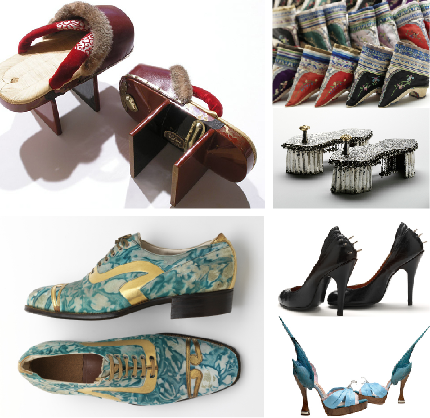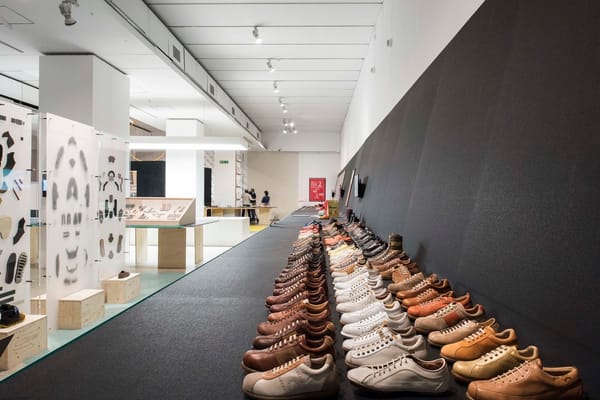Shoes: Pleasure and Pain
Cecile Borkhataria takes a look at the shoe exhibition at the V&A

The V&A’s latest fashion exhibition takes a look at the extremes of footwear from around the world, ranging from Cinderella’s glass slippers featured in the recent Disney live action movie, to tiny lotus shoes used to bind women’s feet in 19th century China. The exhibition focuses on the transformative quality of shoes and their cultural significance, particularly as a symbol of status. With over 200 shoes on display, examples are shown from famous shoe wearers as well as a vast range of historical shoes dating as far back as 30 BCE.
Immediately after walking through the entrance to the exhibition, the dimly lit set-up accompanied with provocative music instantly creates a sensual atmosphere, alluding to the seductive power of certain types of shoes. On a projector, a woman is shown tying on a pair of red heels with ribbons, walking up a flight of stairs and through a hallway in a fitted dress. Here, the message is clear: shoes equal sex. This isn’t just my interpretation though; the exhibition has an entire section entitled Seduction. Footwear, together with feet, have long been fetishised. For women, the shoes most often associated with seduction are, of course, heels. The appeal of heels are numerous. For one, they affect the movement of a woman’s body whilst walking, pushing out the chest and behind whilst lengthening the leg, all of which are titillating for the opposite sex. ‘Stripper heels’ are placed on display, and whilst these may just look like normal heels to many of us, with a long thin heel and a platform, they were originally created for a specific purpose. Strippers originally wore these heels to allow them to grip onto poles, with the platforms providing a firmer footing.
Another section of the exhibition entitled Status gives an insight into the social significance of shoes across the world. For example, large rosettes of gilded or silver lace, appropriately named ‘shoe roses’ were used to emphasise the nobleman’s legs in the 17th century, who would have worn tights to emphasise his calves. Shoes that indicate a high social status are often impractical in their shape and design, making a clear statement that the wearer does not have to walk in their shoes from A to B, but rather would be chauffeured or transported on a horse drawn carriage, far away from dirty, muddy streets. For example, ‘Geta’ shoes were worn by high-ranking Japanese geishas, known as ‘Oiran’, during the feudal era (1186-1600). These were sandals with an elevated wooden base to keep the feet dry in rain or snow. The taller the shoe was, the higher the rank of the geisha. The two supporting pieces below the base board are also made of wood and make a clacking sound when the wearer walks, signalling the presence of a high status geisha.
Some truly weird and wonderful shoes are on display, all telling their own story. A pair of 1938 black ankle boots designed by Andre Perugia (the Christian Louboutin of the time) is draped with flowing Colobus monkey fur, conveying the excesses of the wealthy at the time. During World War II though, the design of shoes was dictated by a lack of material and a sensibility about what was appropriate. Such a pair of shoes is exhibited, made by a shoemaker in Kensington using the clients’ old cheetah print coat.
A number of iconic shoes appear throughout the exhibition, including Sex and the City Carrie Bradshaw’s Manolo Blahnik Mary Jane heels. For those who are more inclined towards sportswear, there’s even a display of Brooklyn football boots worn by David Beckham when he played for Manchester United. For those more interested in the construction process, the upper floor showcases methods of shoe creation and innovative new ways of making shoes using 3D printers.
The bottom line? There’s something for everyone here.








